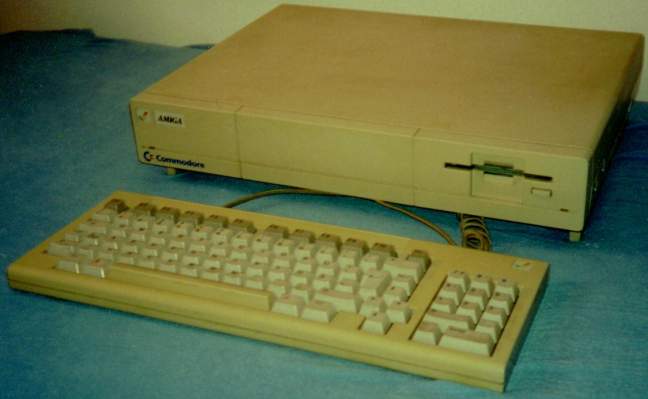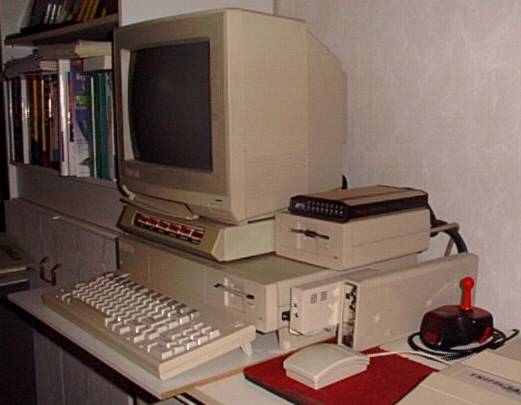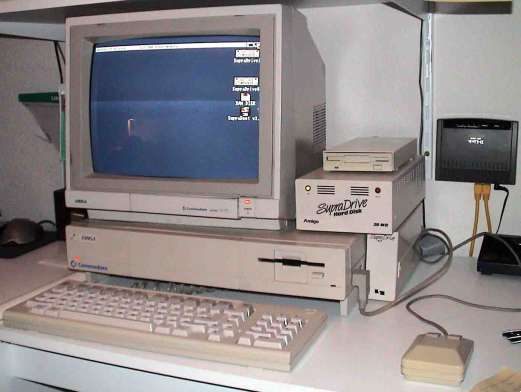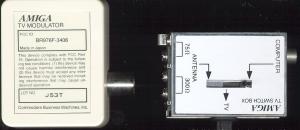



These two pictures show the A1000 without the C= logo. Apparently North American models were not sold with the Commodore logo, only European models were.


The Commodore TV Modulator designed for use with the A1000
Hi Res Picture of the A1000 (1400 x 1056)
Hi Res version of the TV Modulator (949 x 414)
Picture of the case showing the designers signatures. (1315 x 908).
Picture of an A1000 Motherboard (1092 x 824)
Picture of the Belgian/French A1000 Keyboard (962 x 498)
Picture of the US A1000 Keyboard (963 x 507)
Standard Specifications
| Case Type: | Desktop |
| Processor: | 68000@7.14Mhz |
| MMU: | None |
| FPU: | None |
| Chipset: | OCS Early pre-production versions may have had Portia instead of Paula and Daphne instead of denise but this is unconfirmed |
| Kickstarts: | V1.0 (disk based, not ROM) V1.1 (disk based, not ROM) V1.2 (disk based, not ROM) V1.3 (disk based, not ROM) |
| Expansion Slots: | 1 x 86pin Side Expansion Slot 1 x Front Memory Expansion Slot |
| Standard CHIP RAM: | 128K (not confirmed) 256K Note: The A1000 has an additional 256K, but this is reserved for loading Kickstart from disk. |
| RAM sockets: | None |
| Hard Drive Controllers: | None |
| Drive Bays: | 1 x Custom Floppy Drive Bay |
| Expansion Ports: | 1 x 25pin Serial (FEMALE) 1 x 25pin Parallel (MALE) 1 x 23pin RGB Video 1 x 23pin External Floppy 2 x 9pin Joystick/Mouse 2 x RCA Audio (Left/Right) RJ10 Keyboard Connector |
| Floppy Drive: | Internal 880K Floppy Drive |
| Motherboard Revisions: | Unknown |
| Battery Backed Up Clock: | No |
The A1000 was the first commercially available Amiga and stunned the world with its amazing graphics and sound capabilities, long before the term "multimedia" was ever coined. The capabilities the A1000 had, were previously only seen on machines costing 10 times as much. Unlike most Amigas, the A1000 does not contain Kickstart in ROM, instead it loads it from disk. The A1000 contained 256K of memory (in addition to 256K CHIP) which was generally reserved for the Kickstart, however there are numerous expansions which allow the A1000 to use Kickstart ROMs and so this memory can be freed for general use. The 86pin side expansion slot is actually compatible with those found on the A500 and A500+, however it is not located in the same place. The side expansion slot is located on the right hand side of the A1000, whereas on the A500 and A500+ it is on the left. This has the side effect that expansions designed for the A1000, have to be used back-to-front in an A500/+ and vice versa. Another peculiarity are the serial and parallel ports. All other Amigas have 25pin FEMALE parallel ports, and 25pin MALE serial ports, whilst the A1000 has a 25pin MALE parallel port and a 25pin FEMALE serial port. Consequently extreme care must be taken to ensure that any expansions plugged into these ports, are infact plugged into the correct port, with an appropriate adaptor if necessary. Lastly, all other Amiga's which use external keyboards either have a large 5pin DIN connector, or the small PS/2 style connector, the A1000 uses an RJ10 connector which looks a lot like a phone plug.
Please see the A1000 Phoenix.
Thanks to Greg Scott, P-O Yliniemi, Thomas Barth, Leslie Ayling , Richard Wagenfuehrer and Daniel Kraus